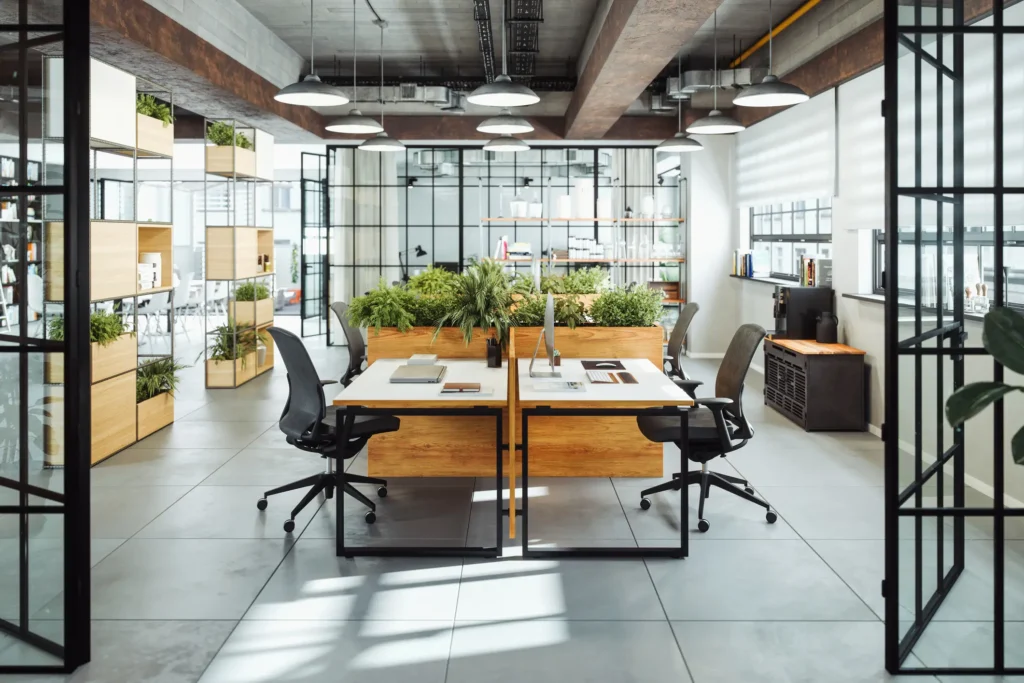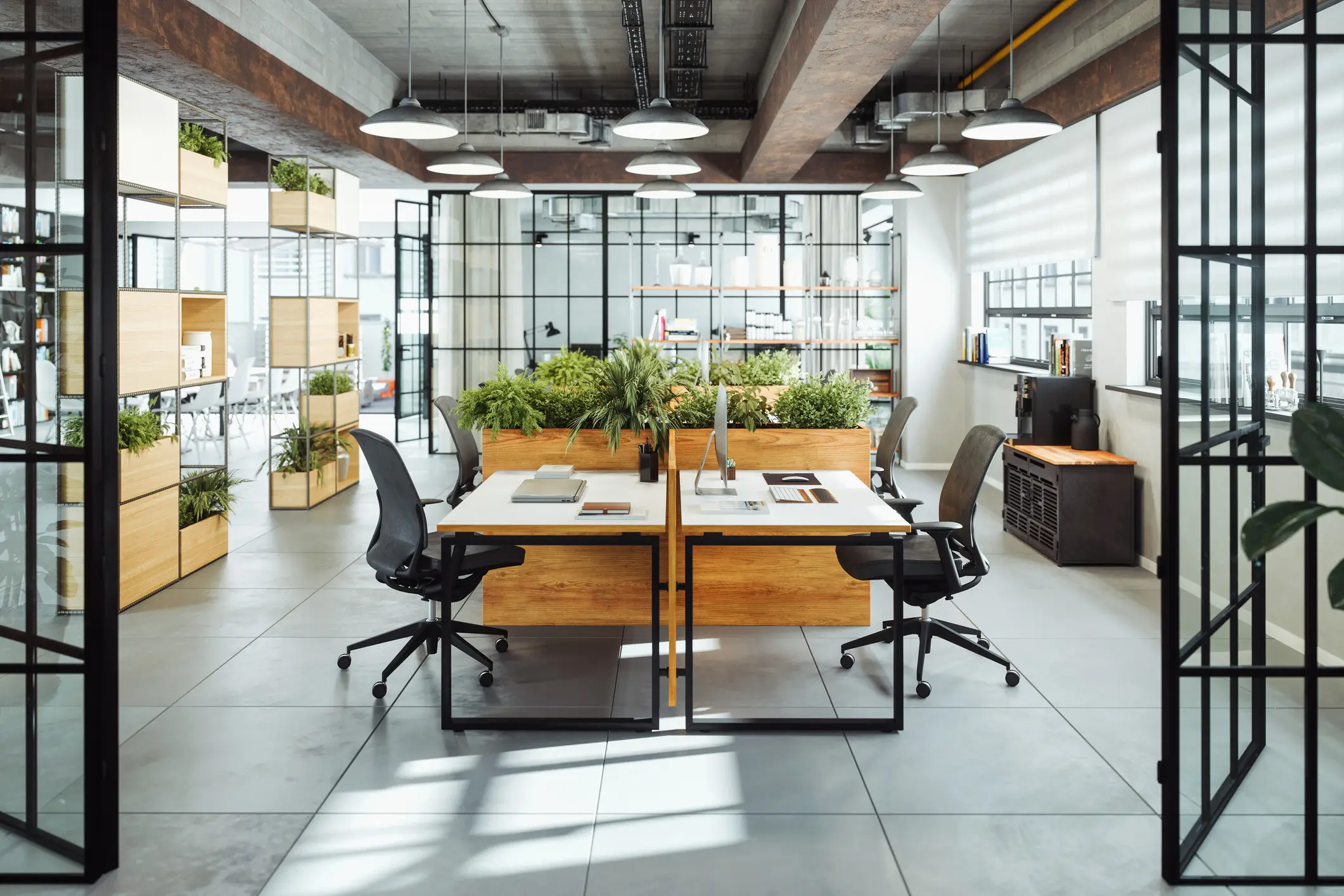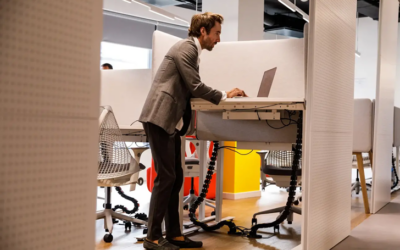
Mixing vs. Matching Office Furniture Styles
When designing your corporate office, one key decision you’ll face is whether to mix or match the furniture. Both approaches have their merits, and the choice largely depends on your budget, the atmosphere you want to create, and how you envision your workspace functioning. Follow this comprehensive furniture style guide to help you decide the best path for your office decor.
Pros & Cons of Mixing or Matching Office Furniture
So, should you pick a single design for the entire office or go for a more varied look? Weigh the pros and cons of each option to help you decide.
Mixing Office Furniture
Pros:
- Eclectic aesthetic: Mixing furniture styles creates a dynamic environment that feels personalized and unique.
- Flexible updates: With mixed furniture, replacing individual pieces down the line is easier and less costly. You won’t have to worry about finding an exact match for a worn-out piece.
- Layered design: Mixing styles add depth and character. Different textures, colors, and eras of furniture combine to create a rich look that evolves over time.
Cons:
- Potential for clashing: The biggest risk with mixing is that it can quickly turn into clashing. Without a unifying theme or color palette, the space can feel chaotic rather than cohesive.
- Complex design process: Using multiple furniture styles in one room requires a good eye for office interior design and a clear vision of the final product. It’s not as straightforward as buying a matching set, which makes the process more time-consuming.
Matching Office Furniture
Pros:
- Cohesive look: Matching furniture creates a clean, unified aesthetic. It’s easy on the eyes and ensures everything feels like it belongs.
- Simplified shopping: When your furniture matches, shopping is fast and easy. You can purchase pieces from the same collection, knowing it will all work together.
- Professional appearance: Coordinated office furniture gives off a more traditional vibe, which may be important in professional settings.
Cons:
- Limited personality: A completely matched office may feel overly uniform or sterile, missing the warmth and individuality that mixed pieces bring.
- Higher replacement costs: If a piece gets damaged, finding an exact match can be tricky if the original collection is no longer available. You might end up replacing more than just the damaged piece to maintain consistency.
Mixing vs. Clashing
There’s a fine line between expertly mixing office furniture and clashing different styles. The key is to choose pieces that complement each other, even if they don’t technically match. Here are some office decor tips to ensure your selections work together:
- Start with a focal point: Choose a main piece of furniture, like a desk or a prominent chair, and build the rest of the room around it. This maintains a cohesive feel even with different styles at play.
- Stick to a color palette: Use a consistent color scheme across different pieces to tie everything together.
- Mix textures: Combining leather with wood or metal with fabric creates visual interest without overwhelming the space.
- Repeat elements: Look for ways to use certain colors or materials multiple times throughout the room. This repetition creates unity without being too matchy-matchy.
- Consider functionality: Don’t just think about how pieces look together; consider how they will work Make sure mixed pieces don’t disrupt workflow or cause overcrowding.
Furnishing Your Office
Whether you’re starting from scratch or upgrading an existing workspace, the furniture you choose will affect your office’s productivity and atmosphere. Ask a few important questions to get your furniture shopping venture off to a good start.
What Office Furniture Do You Need?
Every office requires a few basic pieces to function efficiently.
- Work desks: Your team’s work desks should be functional, comfortable, and suited to the job requirements. Consider Sit to Stand desks if flexibility and ergonomic benefits are high priorities.
- Office chairs: Choose chairs that provide good lumbar support and adjustability. Mixing different styles can work well, especially if you stick to a consistent color scheme.
- Reception desks: This is the first point of contact for visitors and clients, so it should make a strong impression. A stylish and functional reception desk sets the tone for the rest of the office.
- Waiting room chairs: These should be comfortable and durable. Feel free to mix styles for added personality, but make sure they complement the reception area’s overall design.
- Conference room tables: As a key piece for business meetings, conference tables should be large enough to accommodate everyone while fitting the room’s scale. Mixing different styles of chairs around the table can create a unique look.
- Filing cabinets and storage: These organizational solutions should be strategically placed to avoid clutter. Choose styles that match or complement the desks to maintain a cohesive look.
- Workstations and benching systems: Open office layouts are a current trend. Mixing different types of workstations can meet your employees’ varied needs, whether they require more privacy or a collaborative setup.
Will You Buy New or Used?
When deciding whether to buy new or used office furniture, consider your budget, style preferences, and the necessary functionality. New furniture offers the latest designs, customization options, and warranty coverage, but the offerings tend to be more expensive and might involve longer wait times for delivery.
On the other hand, used furniture is typically more affordable, immediately available, and environmentally friendly, though it may have limited style options and existing wear. You may want to mix high-quality new pieces with cost-effective used items for a balanced, stylish workspace that doesn’t break the bank.
Are You Replacing Any Items?
If you’re upgrading an existing office, consider which pieces need replacing and which ones still have some life left. Prioritize replacing obsolete items that no longer serve a purpose, beat-up furniture that detracts from the office’s overall look, and out-of-style pieces that no longer work with your vision.
Don’t forget—you might be able to sell your old furniture to free up space and offset the cost of new purchases. Pursue this option if the furniture is still in good condition but no longer fits your office’s needs. Otherwise, recycling or disposing of old furniture may be your best bet.
Office Decor Tips
Creating a stylish and efficient corporate office involves more than just choosing the right furniture. It’s about bringing all the elements together into a cohesive environment. Here are some office decor tips to optimize style, comfort, and productivity.
- Choose ergonomic seating: Ergonomic furniture helps your employees stay comfortable and healthy. Invest in ergonomic office chairs that offer adjustable features and proper lumbar support. Consider varying the types of seating available, from high-back chairs to loungers, to accommodate different preferences.
- Play with furniture placement: Sometimes, simply rearranging the furniture is enough to refresh your office without buying new pieces. Try moving a sofa table to a different location or shifting chairs to create a more open, functional layout.
- Add flexible seating: Incorporate multicolored stacking chairs or stools in your office design. These are perfect for adding a fun element to last-minute meetings, collaborative work, or accommodating extra visitors.
- Consider the impact of lighting: Lighting is a crucial aspect of office design that can greatly affect mood and productivity. Natural light is ideal, so position desks near windows if possible. For artificial lighting, mix overhead lights with stylish lamps to ensure every workspace is well-lit.
- Refresh the paint and carpet: If your new furniture doesn’t quite match your current decor, consider repainting the walls or replacing the carpet to better harmonize with your updated pieces.
- Create zones for different activities: In larger offices, creating distinct zones improves workflow and organization. For example, designate areas for collaborative work, quiet zones for focused tasks, and comfortable lounges for breaks. Use furniture placement, rugs, and partitions to define these spaces.
- Incorporate personal touches: Make your office feel more welcoming by hanging artwork, displaying artificial plants, or incorporating elements that reflect your company’s culture. Even small changes like updating photos or moving decor to a different wall can refresh the space.
- Think about long-term flexibility: As your business evolves, so might your office needs. Consider modular furniture that can adapt to different layouts or be easily reconfigured, allowing your office to grow and change with you.
Create Your Ideal Office
Office Furniture Expo has been proudly serving the Atlanta Metro area and beyond since 1981. With over 100,000 sq. ft. in our Showroom, we truly are the superstore of office furniture. Come check out our vast selection of new, gently used, and special-order pieces to fit your unique space. You won’t find another Atlanta office furniture store quite like ours! Contact us today to request a free design consultation.






0 Comments